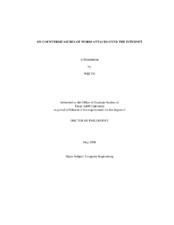| dc.description.abstract | Worm attacks have always been considered dangerous threats to the Internet since they can
infect a large number of computers and consequently cause large-scale service disruptions and
damage. Thus, research on modeling worm attacks, and defenses against them, have become
vital to the field of computer and network security. This dissertation intends to systematically
study two classes of countermeasures against worm attacks, known as traffic-based
countermeasure and non-traffic based countermeasure. Traffic-based countermeasures are those
whose means are limited to monitoring, collecting, and analyzing the traffic generated by worm
attacks. Non-traffic based countermeasures do not have such limitations.
For the traffic-based countermeasures, we first consider the worm attack that adopts feedback
loop-control mechanisms which make its overall propagation traffic behavior similar to
background non-worm traffic and circumvent the detection. We also develop a novel spectrumbased
scheme to achieve highly effective detection performance against such attacks. We then
consider worm attacks that perform probing traffic in a stealthy manner to obtain the location infrastructure of a defense system and introduce an information-theoretic based framework to
obtain the limitations of such attacks and develop corresponding countermeasures.
For the non-traffic based countermeasures, we first consider new unseen worm attacks and
develop the countermeasure based on mining the dynamic signature of worm programs’ run-time
execution. We then consider a generic worm attack that dynamically changes its propagation
patterns and develops integrated countermeasures based on the attacker’s contradicted
objectives. Lastly, we consider the real-world system setting with multiple incoming worm
attacks that collaborate by sharing the history of their interactions with the defender and develop
a generic countermeasure based on establishing the defender’s reputation of toughness in its
repeated interactions with multiple incoming attackers to optimize the long-term defense
performance.
This dissertation research has broad impacts on Internet worm research since this work is
fundamental, practical and extensible. Our developed framework can be used by researchers to
understand key features of other forms of new worm attacks and develop countermeasures
against them. | en |


